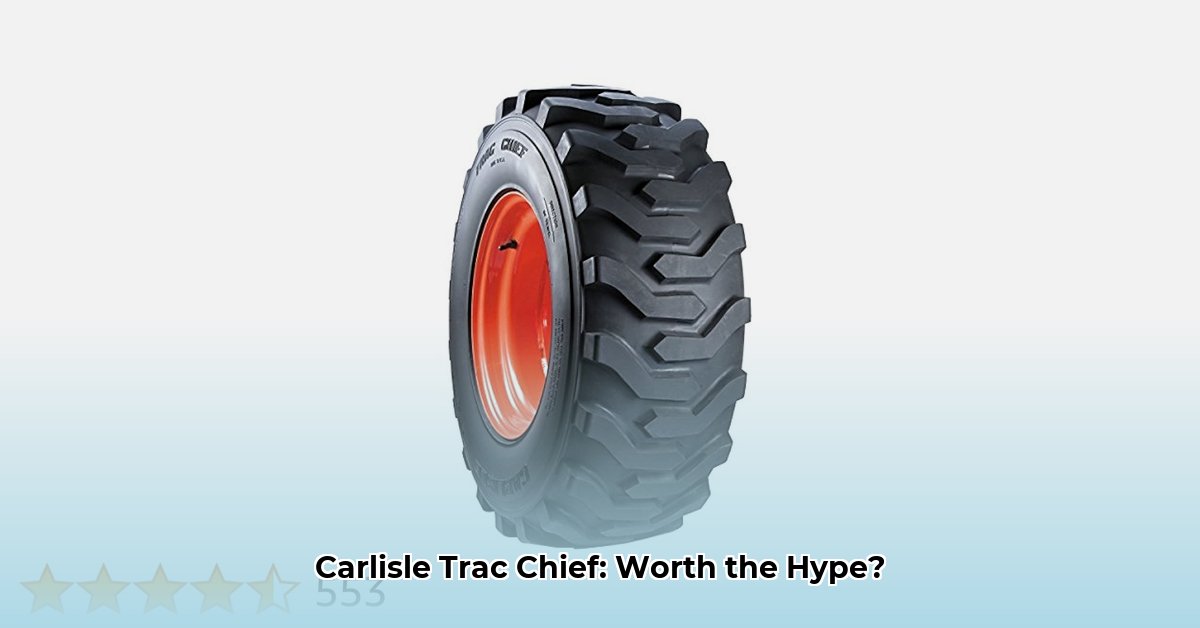
Picking the right tires for your tractor or farm equipment is crucial. This detailed review focuses on the Carlisle Trac Chief 25x8.5-14 bias-ply tire, examining its features, performance, and comparing it to alternatives. Whether you're a seasoned farmer or a first-time buyer, this guide will help you make informed decisions. For more tire options, check out this helpful resource: tractor tire sizes.
Getting to Know the Carlisle Trac Chief: Design and Build
The Carlisle Trac Chief 25x8.5-14 utilizes a bias-ply construction. This means the tire's rubber layers run at an angle, resulting in exceptional strength and resilience. This makes it ideal for rough terrain and applications where punctures are a concern. The sidewalls are reinforced for added protection against impacts. The aggressive tread pattern is designed for optimal grip in various soil conditions, especially muddy or loose surfaces.
Performance: A Deeper Dive
Carlisle claims exceptional durability and high load capacity. While these are promising, independent verification is needed. We require rigorous testing data to assess these claims fully. Independent load rating certifications and comparisons against competitors are crucial for a comprehensive evaluation.
Bias-ply tires, like the Trac Chief, generally exhibit higher rolling resistance than radial tires. This translates to potentially lower fuel efficiency. The extent of this reduction needs further investigation through testing across diverse operational scenarios. The trade-off lies in the greater durability of a bias-ply tire; the long-term cost-benefit needs more data for effective comparison.
The Carlisle Trac Chief vs. The Competition
Direct comparison to other 25x8.5-14 tires in the market is essential. While specific, manufacturer-provided data is available for many competitors, independent testing is critical to understand the relative performance differences in terms of longevity, puncture resistance, and overall durability. This detailed analysis will allow for a truly informed buying decision.
Keeping Your Tires in Top Shape: Maintenance and Care
Prolonging the life and performance of your 25x8.5-14 tires requires diligent maintenance:
Maintain Proper Inflation: Always check and adjust tire pressure according to your tractor's manual. Underinflation causes increased wear and tear, while overinflation risks premature tire failure.
Regular Inspections: Regularly inspect your tires for cuts, embedded objects, and unusual wear patterns. Early detection prevents minor issues from escalating into major problems.
Smart Storage: When not in use, store tires in a cool, dry place, away from direct sunlight and extreme temperatures. This safeguard protects the rubber from degradation.
Tire Rotation: Follow the manufacturer's recommendations for tire rotation to ensure even wear across all tires, extending their lifespan.
The Bottom Line: Weighing the Pros and Cons
The Carlisle Trac Chief offers a durable solution, particularly for challenging terrains. However, without robust independent testing data, it’s difficult to definitively assess its true value against similar products.
Pros:
- Durable bias-ply construction
- Aggressive tread for traction
- Reinforced sidewalls for impact resistance
Cons:
- Higher rolling resistance than radial tires
- Lack of comprehensive independent performance data
- Potential for higher long-term costs if durability claims are not fully met
Your choice will depend on your specific needs and priorities. The decision comes down to weighing the trade-offs between fuel efficiency and durability. Is the increased resilience worth the potential decrease in fuel economy?
How to Compare Carlisle Trac Chief Bias Tire Performance to Radial Alternatives
Bias-ply tires, like the Carlisle Trac Chief, offer a lower initial cost and are suitable for lighter-duty applications. However, radial tires (especially IF and VF types) usually provide superior fuel efficiency, longer lifespan, and reduced soil compaction.
A comprehensive cost-benefit analysis is essential, examining long-term savings and increased yields alongside the initial investment. Direct comparisons with specific radial brands (e.g., Michelin, Titan) necessitate further research and analysis, focusing on real-world performance in diverse conditions. Remember, proper inflation is crucial for both radial and bias tires to optimize performance.
Conclusion: Choosing the Right Tire
Selecting between bias-ply and radial tires demands careful consideration of your operational needs and long-term goals. While the Carlisle Trac Chief presents a cost-effective option for specific tasks, radial alternatives often offer superior performance advantages and contribute to sustainable agricultural practices. Prioritize a thorough cost analysis that encompasses initial price, fuel efficiency, tire lifespan, and the overall impact on your operation's productivity and long-term financial well-being.